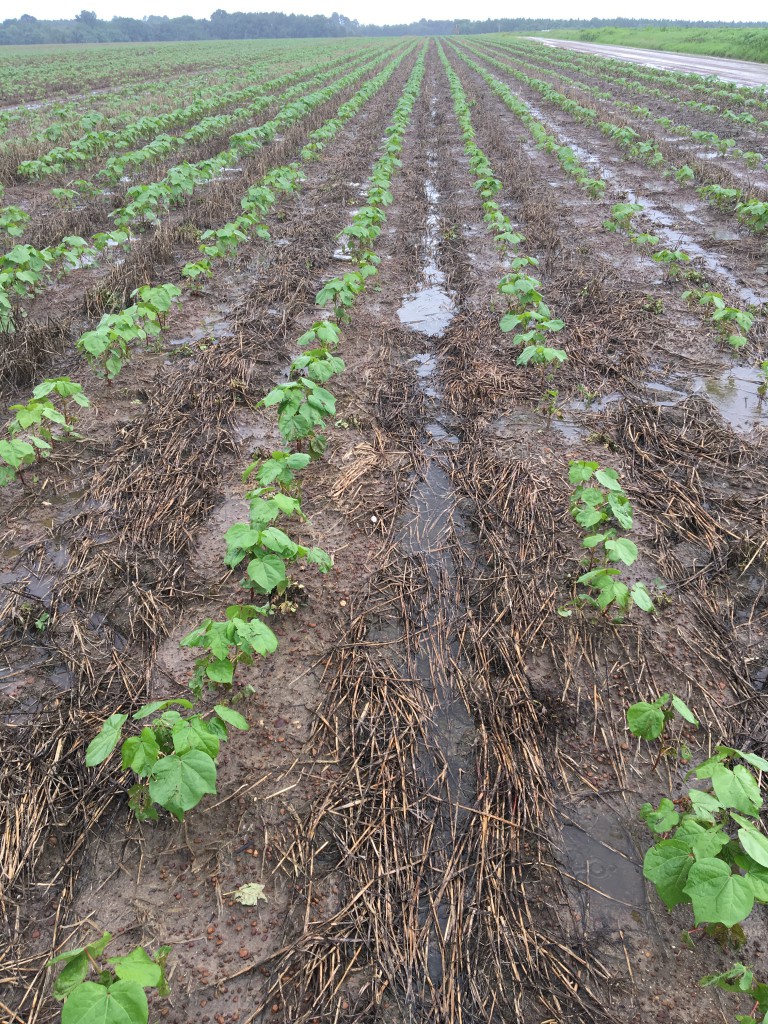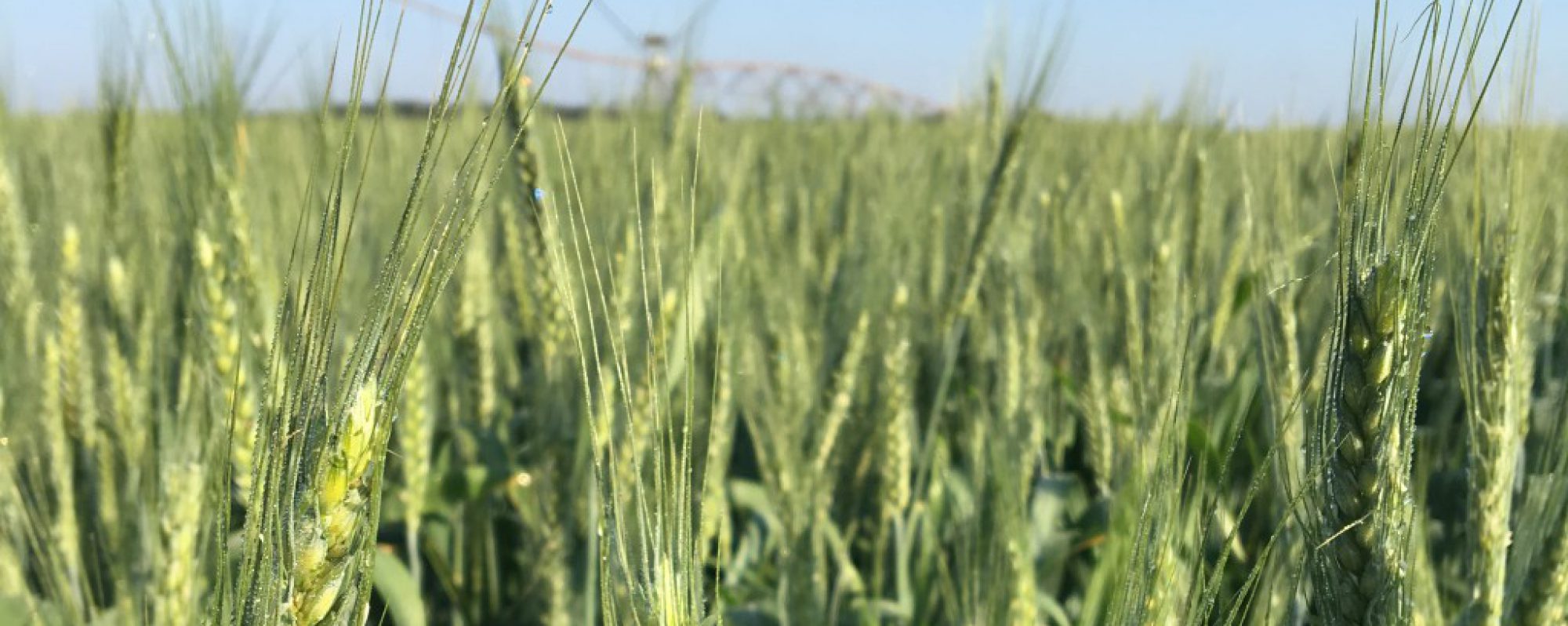
We still have water standing in our fields across the county, even Thursday as it has been mostly sunny. I took this picture as it was starting to rain again in Pitts on Wednesday. UGA Extension Cotton Agronomist Dr. Jared Whitaker says we got about 30 – 40% more cotton to plant in Georgia. With this rain, some of our cotton will be planted outsidide of our normal planting window. This will change our management in many respects. The best recommendation for now: Plant ASAP.
Dates to consider
- June 5th – Our insurance date for South Georgia
- June 8th or 10th – Late cotton, yield potential declines sharply
- June 15th – STOP planting. (In some situations, we can get away with it, but most we are not).
Management
If we plant before June 5th, plant/manage as normal
If we plant after June 5th:
- Increase seeding rate 25% (we need 2 plants per row foot)
- Keep with same variety (Early vs. late maturing)
- Cut N rates 25 – 30% (Both at planting and sidedressing)
- Plant Growth Regulators is the best way to manage earliness
- Irrigate but don’t let it stress
Here is more from the UGA Cotton Team
Undoubtedly, this course of events will force producers to plant a significant portion of the cotton crop during the month of June. This year a much larger portion of the crop will be planted in June than normal and there are several things to consider which may dramatically impact the relative success of these acres.
YIELD POTENTIAL is the reason that most of the crop is typically planted prior to early June. Research in Georgia has indicated that yield potential usually starts to diminish with plantings after the first week to 10 days or so of June. The relative success of late-planted cotton is certainly dependent upon the weather in September and October as well as the date of the first frost, but we can also impact it by a couple of management decisions.
Getting a Stand
The most important thing to consider when planting late is that there is very little, if any, room for error. When we plant this late, we get only one shot at a stand. If a replant is required we are likely past any window for maximizing yields and past any insurance deadlines. Conditions need to be ideal and if irrigation is available, utilize water as needed to prevent soil crusting or enhance stand establishment. If planting in dryland situations, it would be best if the soil were to slightly crust prior to planting, as the planting operation would break the crust and allow for quick emergence (but as late as it is, go when it’s possible). A rotary hoe is a great tool to help with compacted soil around germinating and emerging seed, but be sure to use this tool early rather than later (typically 2-3 days after planting is best).
Seeding Rates
Generally we shoot for final plant stands of at least 1.5 to 1.75 plants per row-ft (in 36” rows) which can usually be accomplished with seeding rates as low as 2.0 seeds per row-ft. In addition to the impact of limited stands in late-planted cotton, there is likely a benefit to a thicker than usual stand due to the fact that late-planted cotton has less time to make cotton on outer and upper fruiting positions and more stalks often equates to higher yields. Therefore, we should adjust our seeding rates to aim for a final stand of around 2 plants per row-ft rather than 1.5.
Herbicidies
It is extremely important to eliminate weed pressure as much as possible in late-planted situations. However, the impact of cotton injury from PRE herbicides can be worse on late-planted cotton than earlier planted cotton due to less time for growth and development. Additionally, Warrant is an excellent PRE herbicide for cotton, remember that UGA recommends that if Warrant is applied PRE to cotton, a total of 21 days should pass before replanting OR a tillage operation is needed. With the extremely limited amount of time that we have if we must replant, this could be a deal breaker. For example, if we planted a field this week (June 1) and on June 10th we realized a heavy rain event caused compaction and left a less than desirable stand, we would not be able to jump out there and replant if we used Warrant PRE (we’d need tillage or another eight days).
PGRs / Irrigation
Overall crop management is always an important issue but this importance is magnified for a short season crop. If irrigation is available all care should be taken to ensure rapid stand establishment, decrease any stress, and enhance fruit retention during episodes of dry weather. Careful consideration should also be made to the plant growth regulator program (PGR). Mepiquat containing PGRs should be applied to prevent any excessive vegetative growth and boll rot and to promote crop earliness.
Insects
The crop should be scouted regularly for insects to prevent stresses from feeding damage and gaps in fruit development which can delay maturity. Thrips are the biggest threat to seedling cotton. Later planted cotton is usually less at risk of infestation compared to early planted cotton however, this is not always the case. To monitor your thrips risk index locally visit the Thrips Infestation Predictor by using the following link: https://climate.ncsu.edu/CottonTIP. Once fruiting is initiated all threats from plant bugs, stink bugs, and other insects should be monitored and apply insecticide as soon as economic thresholds are reached.
Variety Selection
In particular, should we shift to earlier-maturing “short season” varieties and if so, when should we do it? In theory, this makes sense, as we have a shorter amount of time to produce a crop an earlier or short season variety should more appropriately fit the system. In reality there are a couple of things worth considering before making a change.
- First, the modern varieties that we are planting in Georgia are all “early” compared to some of the earlier “full-season” varieties we were accustomed to (nothing we have now is close in maturity to DP 555 BR).
- The difference in maturity between what we now consider early maturing and late maturing as in most situations, is what we must consider. There is no more than a few days to a week difference at the end of the season.
- For the most part, earlier maturing varieties will perform relatively better at the end of the planting window but we typically find that our best varieties perform best even in late situations. For example, we used data from the 2017 UGA On-Farm Cotton Variety Evaluation Program comparing the performance of varieties across all locations to the locations that were planted on May 25th or later, and it indicates that varieties that performed well early performed well late.
